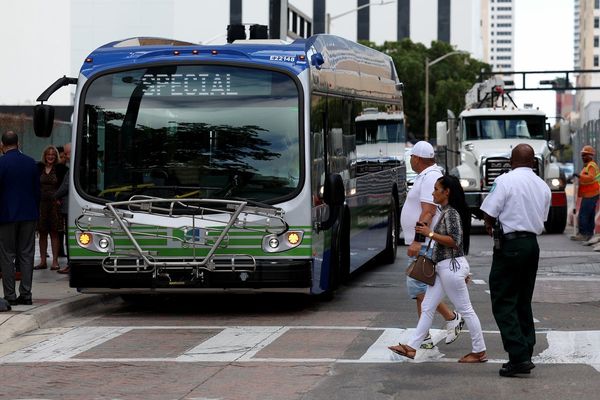
On a crisp December morning, office workers and tourists stroll along a tree-lined stream in central Seoul, pausing on stepping stones that cross its flowing waters. It’s difficult to imagine that just over 20 years ago, this was a vast elevated highway carrying 168,000 cars daily through the heart of South Korea’s capital.
Cheonggyecheon, a stream that runs for about 3.5 miles (nearly 6km) through Seoul, was one of the earliest experiments in an increasing trend in cities globally: turning spaces where there was once car or rail infrastructure into spaces for pedestrians and cyclists. It’s a powerful example of the way that these spaces can become loved and popular, along with projects such as the High Line in New York, where an old railway track has been turned into a raised park, or the city moat in Utrecht, where a multi-lane road (nicknamed the “motorway from nothing to nowhere”) was converted back into a canal, in part of a huge continuing push to allow pedestrians and cyclists to dominate the city’s centre.
Plenty of regrets have followed the 20th-century rush to build infrastructure for cars, and some of the monstrosities that have resulted. Planners on every continent now look hard at the ways in which people can be put back at the centre of our cities.
In Seoul, the restored waterway has been a triumph. It doesn’t just provide a peaceful refuge from the city’s busy streets, it serves as a cultural corridor with year-round festivals and performances, while helping cool the surrounding neighbourhoods, fighting air pollution and managing increasingly intense monsoon floods.
“It feels really nice here, it’s one of the main tourist attractions to visit in Seoul,” said Kareem, a tourist from Malaysia. And in fact, the stream’s history mirrors Seoul’s own transformations. For more than 600 years, it served as the city’s vital waterway, managing floods and supporting daily life since the Joseon dynasty (1392-1910). But by the Japanese colonial period in the 1930s, it had become known as “the city’s cancer”, an open sewer that threatened public health.
After the Korean war, desperate refugees built shantytowns along its banks. In the 1960s, Seoul covered it and built an elevated highway, seen then as a symbol of progress and modernisation that could hide urban poverty.
By the late 1990s, Seoul was rethinking its development-first ideology. Two devastating infrastructure collapses, of the Seongsu Bridge in 1994 and the Sampoong department store in 1995, which killed 32 and 502 people respectively, had shaken public faith in the city’s ageing concrete structures. As citizens began demanding sustainable development and a better quality of life, the elevated highway over Cheonggyecheon, requiring either costly repairs or demolition, became a test case for a new way of thinking about urban space.
In 2002, Lee Myung-bak won the Seoul mayoral election (later becoming president) after campaigning to restore the stream. He expedited the project immediately upon taking office, and the restoration was completed in just 27 months at a cost of 386bn won (about £220m).
“Initially, everyone thought it would cause gridlock,” said Park Byung-chul, a local resident. “But people adapted. Now we can’t imagine the highway ever being here.”
According to studies by the Seoul Institute, the area around the stream is now 3.6C cooler than nearby streets, creating a cool corridor through Seoul’s dense centre. The removal of the elevated highway created new wind paths through the city, improving air circulation. Air pollution dropped significantly, with nitrogen dioxide levels falling by 35%.
Wildlife has returned, too: a 2022 survey by the Seoul Institute showed the area now hosted 666 species, including 174 animal species and 492 plant species.
“The project marked a paradigm shift from vehicle-centric transportation policies to human-centred urban planning,” said Minah Park, a curator at the Cheonggyecheon Museum located alongside the stream.
Beneath the natural-looking surface lies sophisticated flood infrastructure. The stream can handle 200-year flood events, with special inlets along its course channelling monsoon rains safely through the city centre towards larger waterways and eventually the Han River.
The project hasn’t been without critics or problems. The original stream was seasonal, running dry outside rainy months. Today’s Cheonggyecheon requires constant maintenance, costing the city 2.9bn won annually. It needs more than 48,000 tonnes of water pumped daily – 40,000 tonnes from treated Han River water and 8,300 tonnes from groundwater – to maintain its flow. Some say this makes it more an artificial and expensive urban waterway than a truly restored stream.
But the project’s success has sparked a wider transformation. The city has since removed 16 other elevated highways, many replaced by public spaces or wider pavements. Cheonggyecheon now attracts more than 12 million visitors a year, having become as central to Seoul life as the city’s ancient palaces or bustling markets.
Its impact extends far beyond Seoul. “We receive visitors from around 30 countries annually through our benchmarking programme,” said Park at the museum, noting interest from Tokyo for plans to remove the Nihonbashi overpass, and Nairobi’s river improvement project.
As cities worldwide grapple with ageing highway infrastructure and the need to reduce emissions while adapting to climate change, Cheonggyecheon offers a compelling option.







